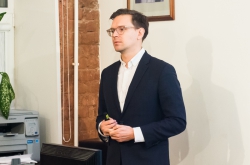How fraud works
The algorithm developed by ITMO students is a decision support system for car insurance companies that can help tell whether some traffic accident is a work of swindlers or not. Nowadays, swindlers concoct minor and major traffic accidents to make their victims cover their insurance payments. Sometimes, policy holders themselves attempt to cheat insurance companies by burning their cars or inducing other damage in order to claim insurance.
According to the data by the Russian Association of Motor Insurers, in 2016 the losses of insurance companies from swindling related to OSAGO (compulsory third-party liability insurance) supposedly amounted to 40 billion rubles. Apart from concocted accidents, this estimate also includes other types of swindling, such as forging of documents and the like.
 Car accident. Credit: shutterstock.com
Car accident. Credit: shutterstock.com
So, how does one identify swindlers? First, the companies check all of the documents provided by the client, and all the suspicious ones are double-checked by a special department. Enclosed photographs of the accident are checked for any alterations and against the testimonies of witnesses. For instance, the time of the day on the photographs can differ from what is stated in the documents. Dashcam footage can be also used to uncover frauds; security experts at insurance companies are well familiar with all the classic swindling schemes..
Indirect factors can be a source of information, as well. For instance, every year in Russia there are regions where most insurance claim payments are made - one can assume that most swindlers operate in these areas. The Russian Association of Motor Insurers states that overcharged insurance claim payments are often induced by traffic lawyers who purchase the victims’ rights to claim insurance payments, and then apply to court having unfairly increased the real amount of damage.
How AI can help
Major insurance companies store data on all insurance events, including those related to frauds. Machine learning can help find common factors and patterns which, in turn, can help identify the work of swindlers. This way, when one makes a claim to a company, it can be classified according to particular parameters and checked against known swindling schemes using machine learning algorithms. As of now, similar analysis is conducted by human experts, yet there are two problems: it is costly, and there’s also the human factor.

Thus, the organizers of RAIF-Challenge 2017 set a task to develop an algorithm for identifying swindling schemes related to traffic accidents. Over the course of a month, the participating teams were to create a program which they then presented to an expert jury from the championship’s partner company AlfaStrakhovanie.
According to Master’s student Sergei Menshov, ITMO team captain (other team members being Bachelor’s students Natalia Slepkova and Sofia Titova), each team got data on 8,500 insurance cases, 10% of which were fraudulent. The programmers had to classify these schemes, use machine learning to find common factors and patterns and reduce them to a set of parameters that can be used by an AI to define whether a particular insurance event is a fraud or not.
How anti-fraud AI operates
The team from ITMO University has developed several classification systems. For instance, one was based on the vehicle model. Cars were broken into the two types: the more expensive ones and others - it seems natural that it is more profitable to concoct accidents involving the more expensive cars. Also, Master’s students used the data on regions where there are most swindling schemes. Other factors have been classified, as well: drivers’ ages and driving experience, vehicle color, the time of day, etc. - more than a hundred factors altogether.
 Sergei Menshov
Sergei Menshov
“Our task was also to choose the factors that can really help identify a fraud. For instance, we’ve learned that the colour of the car is of no importance, while the driving experience of the perpetrator is - five years at the least. In essence, it is important to develop an algorithm for proper data interpretation, so that the program would not call an innocent person a swindler,” comments ITMO team captain.
In any case, such algorithms will not play the decisive role in assessing a traffic accident’s “authenticity”, but simply act as decision support systems - they can save insurance experts from additional routine work on things like initial analysis and identification of suspicious cases.
For their program, ITMO’s students used a neural network and the AdaBoost machine learning algorithm. The main issue for them was the lack of data on concocted insurance events, which constituted only 10% of the given data. The team underlines that in order to continue developing the program, at least 5,000 cases of fraud have to be analyzed. This will allow them to increase the algorithm’s precision.
 RAIF Conference. Источник: raif.jet.su
RAIF Conference. Источник: raif.jet.su
Competition results
“We were especially interested in solving a task in the field of insurance, as there is less uncertainty involved; we simply had to develop a classification of particular parameters. For instance, the competition’s other categories - “Retail” and “Banks” - involved many more factors that were hard to predict, like a product’s popularity in “Retail” or customer outflow in “Banks”. What is more, by helping identify swindlers, we’ve been doing something socially important,” comments Sergei Menshov.
ITMO University students made it to the list of the competition’s winners, which granted them the opportunity to participate in the Russian Artificial Intelligence Forum. At the forum, the young specialists got to listen to lectures by experts in the field of machine learning from such companies as Yandex and IBM, as well as participate in sessions on AI in insurance. As of today, insurance companies have only started to introduce AI to their operations, but further data analysis will allow them to increase the decision support systems’ accuracy. What’s more, many companies are planning to increase the amount of staff working on such projects.
As for the students, they are planning to continue working on their anti-fraud project.





